Overview
This article delves into the critical features essential for the development of effective telemedicine applications. It underscores the necessity of user interface design, data security, and EHR integration. To achieve success, telemedicine applications must prioritize:
- User-friendly interfaces
- Robust security measures
- Seamless integration with existing healthcare systems
These elements are vital for enhancing patient engagement and improving overall care delivery. By focusing on these key aspects, developers can create applications that not only meet the needs of users but also elevate the standard of care provided in the healthcare sector.
Introduction
The rapid evolution of healthcare technology has catalyzed a surge in telemedicine, fundamentally transforming the connection between patients and providers. As the demand for remote medical services skyrockets, it is crucial for healthcare organizations to grasp the essential features of telemedicine app development to enhance patient care and operational efficiency. However, with the promise of improved accessibility and streamlined communication comes the formidable challenge of navigating security concerns and user engagement.
What are the key functionalities that can make or break a telemedicine application in this competitive landscape?
SDA: Custom Telemedicine App Development Services
SDA excels in telemedicine app development, delivering tailored solutions that effectively address the unique needs of providers. Their offerings encompass end-to-end app design, development, and seamless integration, ensuring each application is both functional and user-friendly. By utilizing advanced technologies and a user-focused strategy, SDA empowers medical organizations to enhance client engagement and streamline operational efficiency.
The remote healthcare market is poised for significant growth, with a compound annual growth rate (CAGR) of 17.32% anticipated during the forecast period. This increase is driven by the rising demand for remote medical services and the necessity for effective client management solutions. Successful telemedicine app development projects, such as the integration of Klara's communication platform for individuals, have demonstrated the potential to improve outcomes and optimize workflows, making them essential tools for contemporary medical services.
Customized remote medical solutions offer numerous advantages for care providers, including:
- Improved access to services
- Reduced wait times
- Enhanced communication between individuals and providers
However, challenges such as resistance to change and concerns regarding patient data security and privacy remain significant obstacles in the adoption of digital medical solutions. As the field of remote healthcare continues to evolve, it is crucial for healthcare organizations to stay informed about the latest trends—such as the integration of AI and predictive analytics—to remain competitive and deliver high-quality care.
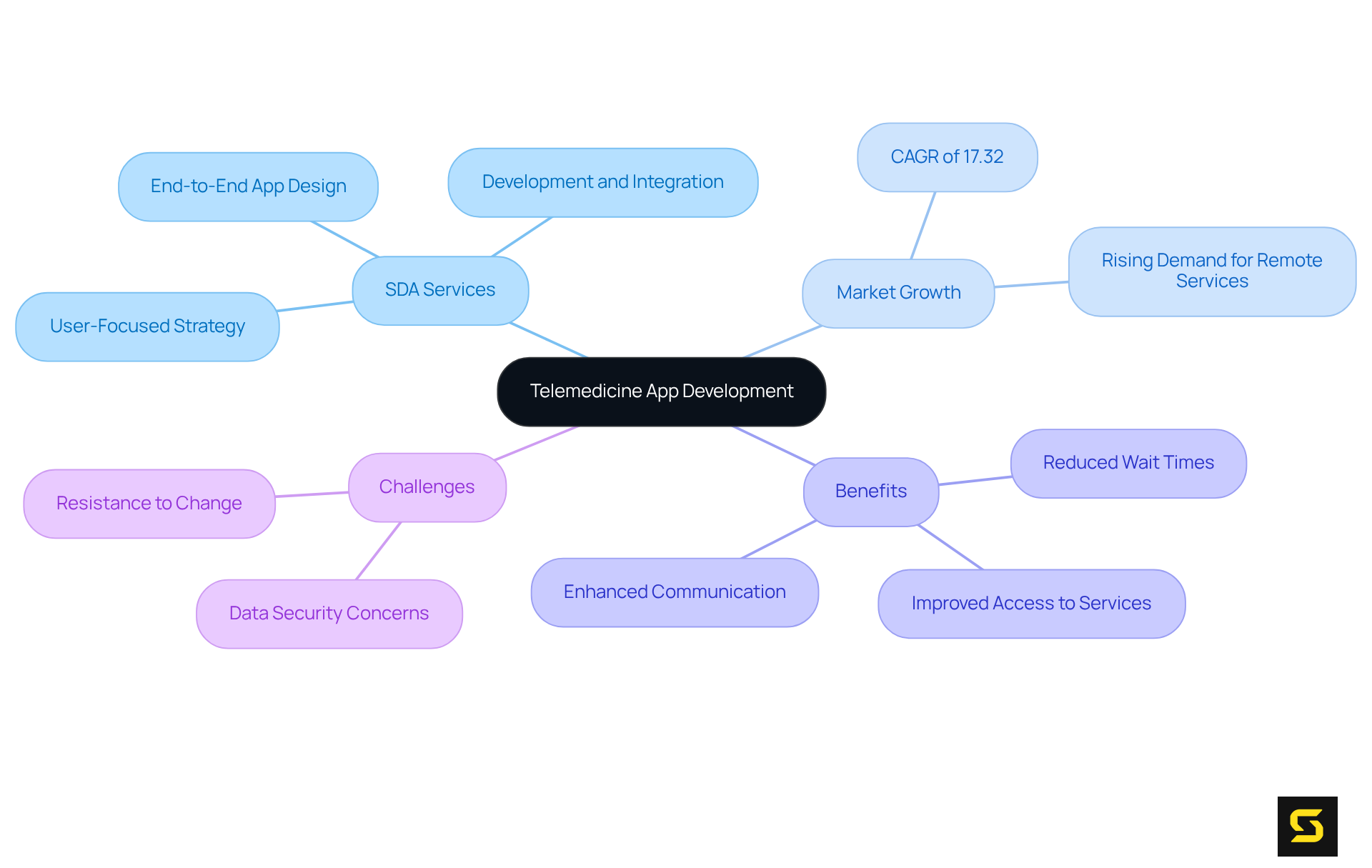
Data Security: Implementing HIPAA Compliance and Encryption
Ensuring data security in healthcare applications is paramount. Strict adherence to HIPAA regulations and the implementation of advanced encryption protocols are not just best practices; they are essential. This includes:
- Utilizing end-to-end encryption for all client communications
- Secure storage solutions for sensitive health information
By prioritizing data security, developers can effectively safeguard individual privacy and uphold adherence to legal standards. This commitment fosters trust in remote healthcare services, ultimately enhancing patient confidence and engagement.
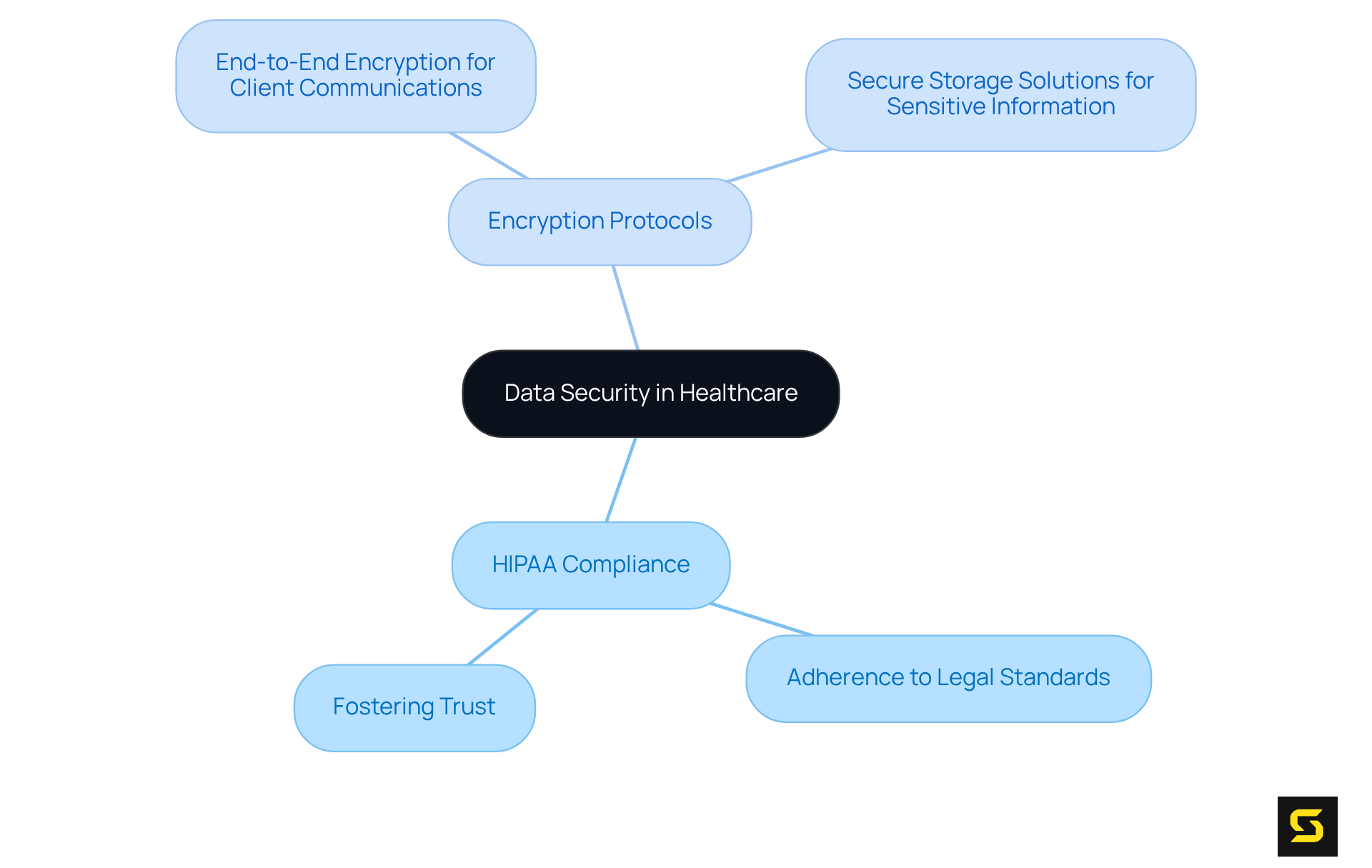
User Interface Design: Creating Intuitive and User-Friendly Experiences
An intuitive user interface is paramount for telemedicine app development, as it significantly influences user engagement and satisfaction. Clear navigation, responsive layouts, and visually appealing elements are essential design principles that effectively guide users through the app. Research shows that 73.1% of web designers attribute visitor drop-off to non-responsive designs, highlighting the critical need for adaptability across devices.
By actively incorporating user feedback during the design process, developers can craft interfaces that accommodate a diverse range of users—from tech-savvy millennials to older patients who may be less familiar with digital tools. Effective remote healthcare applications, especially in the context of telemedicine app development, prioritize user-friendly design, enhancing accessibility and promoting active involvement in health journeys.
This approach not only elevates user satisfaction but also fosters trust; indeed, 94% of buyers do not trust websites with poor interfaces. Furthermore, with 70% of online enterprises failing due to poor usability, a well-crafted UI becomes indispensable for the success of remote healthcare solutions.
Ultimately, a well-designed UI can lead to increased engagement rates, solidifying its role as a crucial element in telemedicine app development for effective remote healthcare solutions.
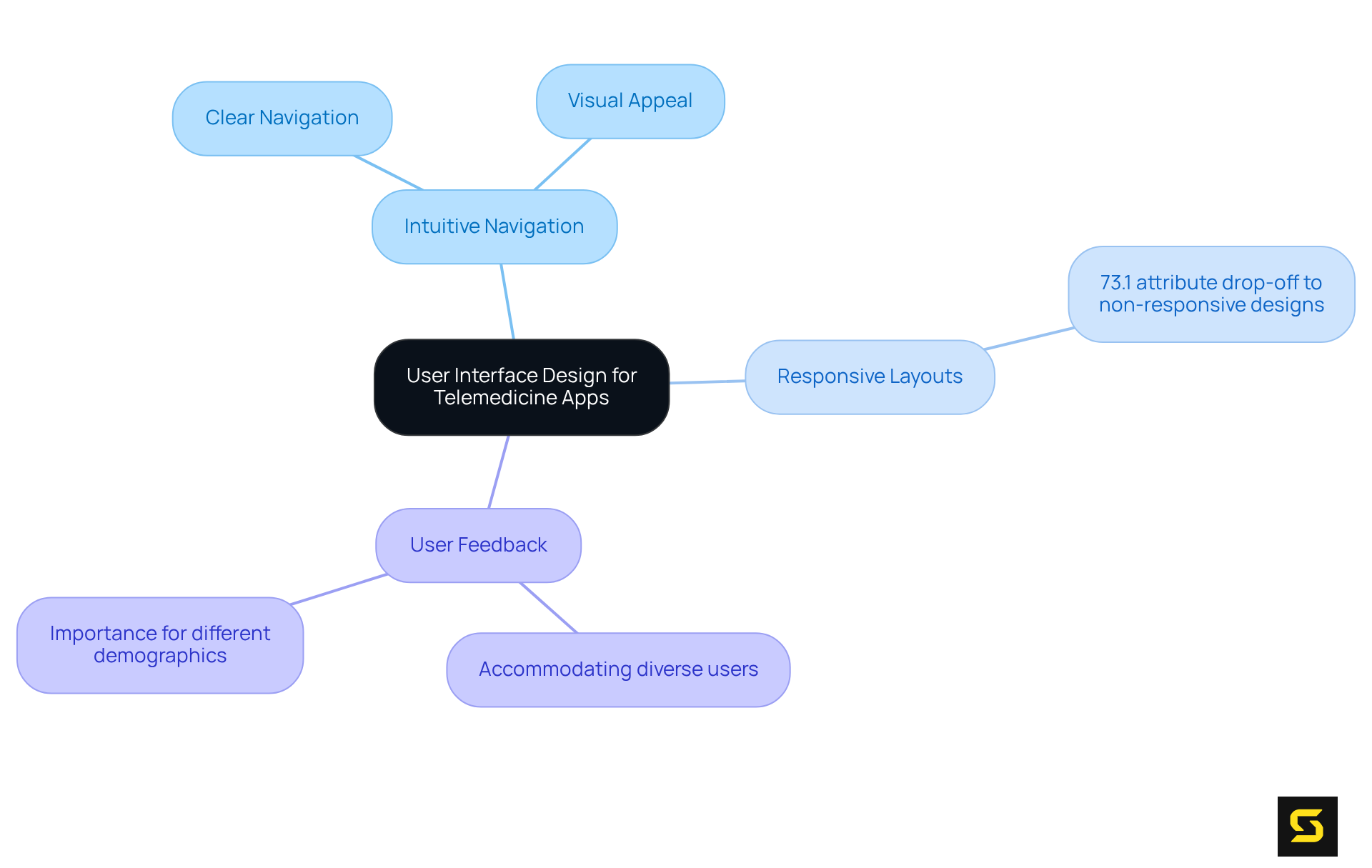
EHR Integration: Ensuring Seamless Data Exchange
Integrating telemedicine app development with Electronic Health Records (EHR) systems is essential for achieving seamless data exchange. This integration empowers healthcare providers to access comprehensive client histories, treatment plans, and other vital information in real-time during consultations. By ensuring compatibility with various EHR systems, developers can significantly enhance care coordination, ultimately leading to improved health outcomes.
Key Benefits of EHR Integration:
- Enhanced Care Coordination: Facilitates real-time access to patient data, enabling informed decision-making during consultations.
- Improved Patient Outcomes: Studies indicate that 93% of physicians utilizing integrated telemedicine platforms reported a quality of care comparable to in-person visits, underscoring the effectiveness of EHR integration.
- Streamlined Workflows: Minimizes administrative burdens by automating data entry and retrieval processes.
As Dr. Mehmet Oz, CMS Administrator, stated, "We have the tools and information available now to empower individuals to enhance their outcomes and their medical experience." This statement highlights the critical role of EHR integration in elevating patient care.
To ensure compatibility with EHR systems, SaaS Product Owners must prioritize the adoption of secure, standards-based application program interfaces (APIs) that comply with the HL7® Fast Healthcare Interoperability Resources (FHIR)® data exchange standard. This approach not only facilitates smooth data transfer but also emphasizes the importance of telemedicine app development as an indispensable tool in modern health service delivery.
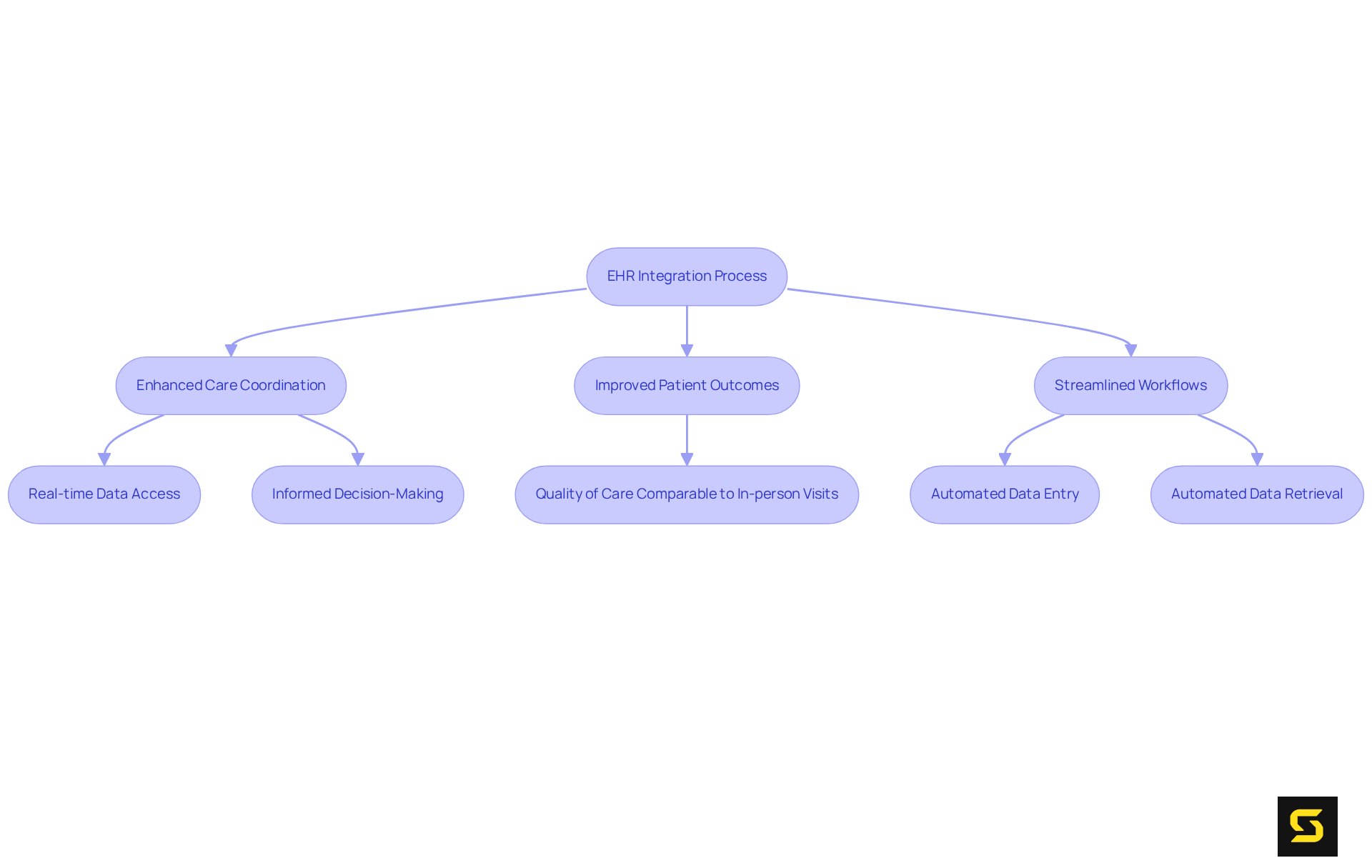
Video Conferencing: Enabling Real-Time Patient Consultations
High-quality video conferencing capabilities are not just beneficial; they are essential for the success of telemedicine applications. These features must facilitate low-latency connections, ensuring that both HD video and audio are clear—critical components for effective communication between individuals and healthcare providers.
Research indicates that video consultations significantly enhance client satisfaction. In fact, 67% of respondents utilized video telehealth services in 2022, with many preferring this format over conventional phone calls due to the visual connection it provides.
Furthermore, incorporating additional functionalities such as:
- Screen sharing
- Virtual waiting rooms
- Robust security features—including HIPAA compliance and data encryption
can enrich the consultation experience, making it more interactive and secure. As remote healthcare continues to evolve, the telemedicine app development that integrates advanced video technology will be pivotal in enhancing healthcare outcomes and overall satisfaction. By eliminating the need for travel, telemedicine can make medical services more accessible to those who might otherwise struggle to receive treatment.
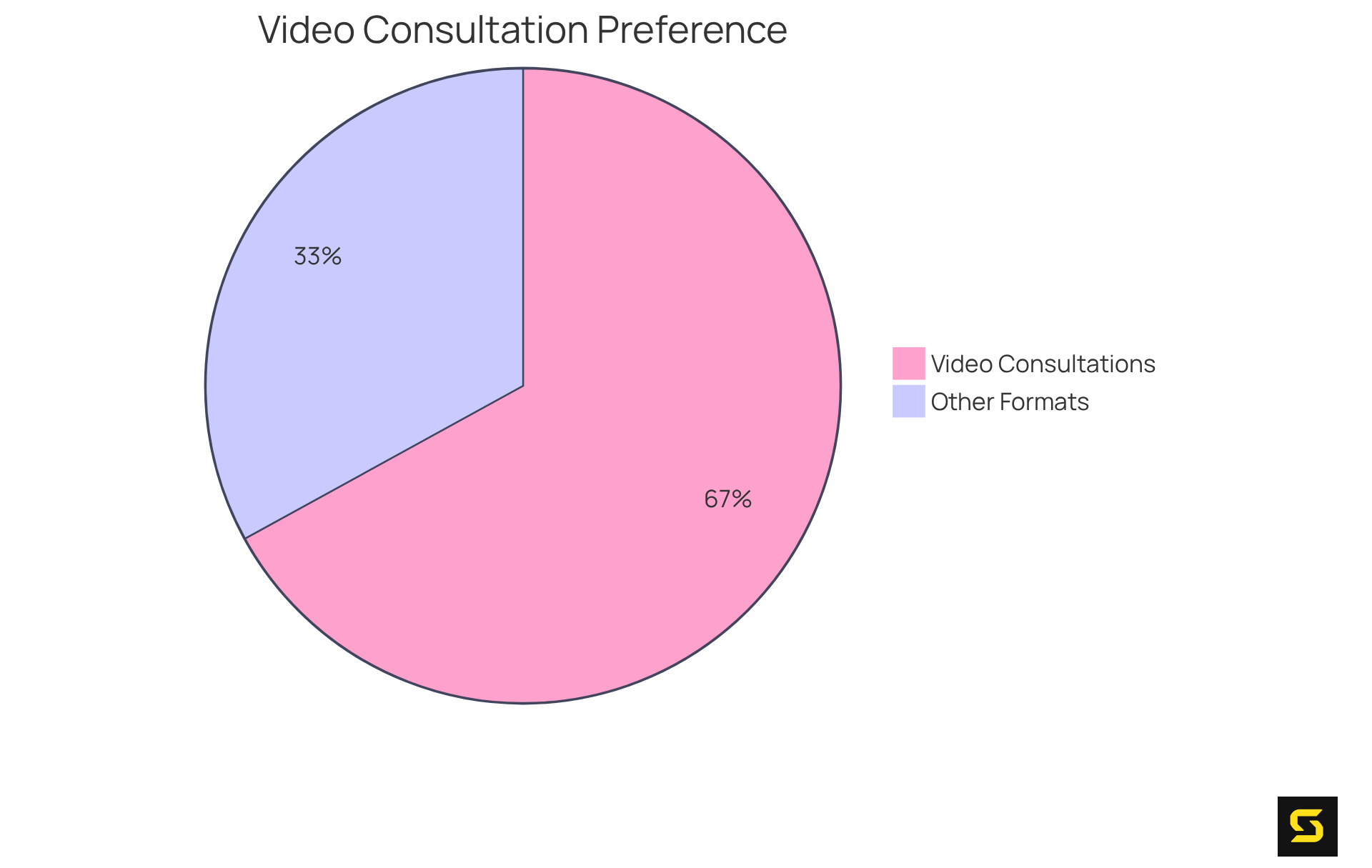
Remote Patient Monitoring: Tracking Health Metrics Effectively
Remote health monitoring (RPM) features empower healthcare professionals to track individuals' health metrics effectively, extending beyond traditional clinical environments. By harnessing wearable devices and mobile health applications, professionals can continuously monitor vital signs, medication adherence, and other essential health indicators in real-time. This proactive strategy facilitates prompt interventions and personalized care plans, significantly enhancing health outcomes.
Notably, statistics reveal that:
- 63% of RPM users report improved medication adherence.
- 80% of physicians assert that RPM leads to better compliance with treatment plans.
- 45% of RPM users experience fewer emergency room visits due to continuous monitoring.
- RPM has demonstrated an impressive 76% reduction in hospital readmission rates.
- Admissions for chronic care complications reduced between 19% and 41% across surveyed organizations, underscoring its effectiveness in managing chronic conditions.
As the integration of wearable technology becomes increasingly prevalent, medical professionals are urged to adopt these solutions to foster enhanced user involvement and health management. The global remote healthcare monitoring market is projected to expand at a compound annual growth rate of approximately 20% from 2023 to 2028, highlighting the growing significance of these technologies.
As one specialist aptly noted, 'RPM is demonstrating to be a transformative element for both individuals and medical practitioners.' Moreover, the home care sector constitutes 55% of RPM applications, indicating a notable shift towards at-home individual care.
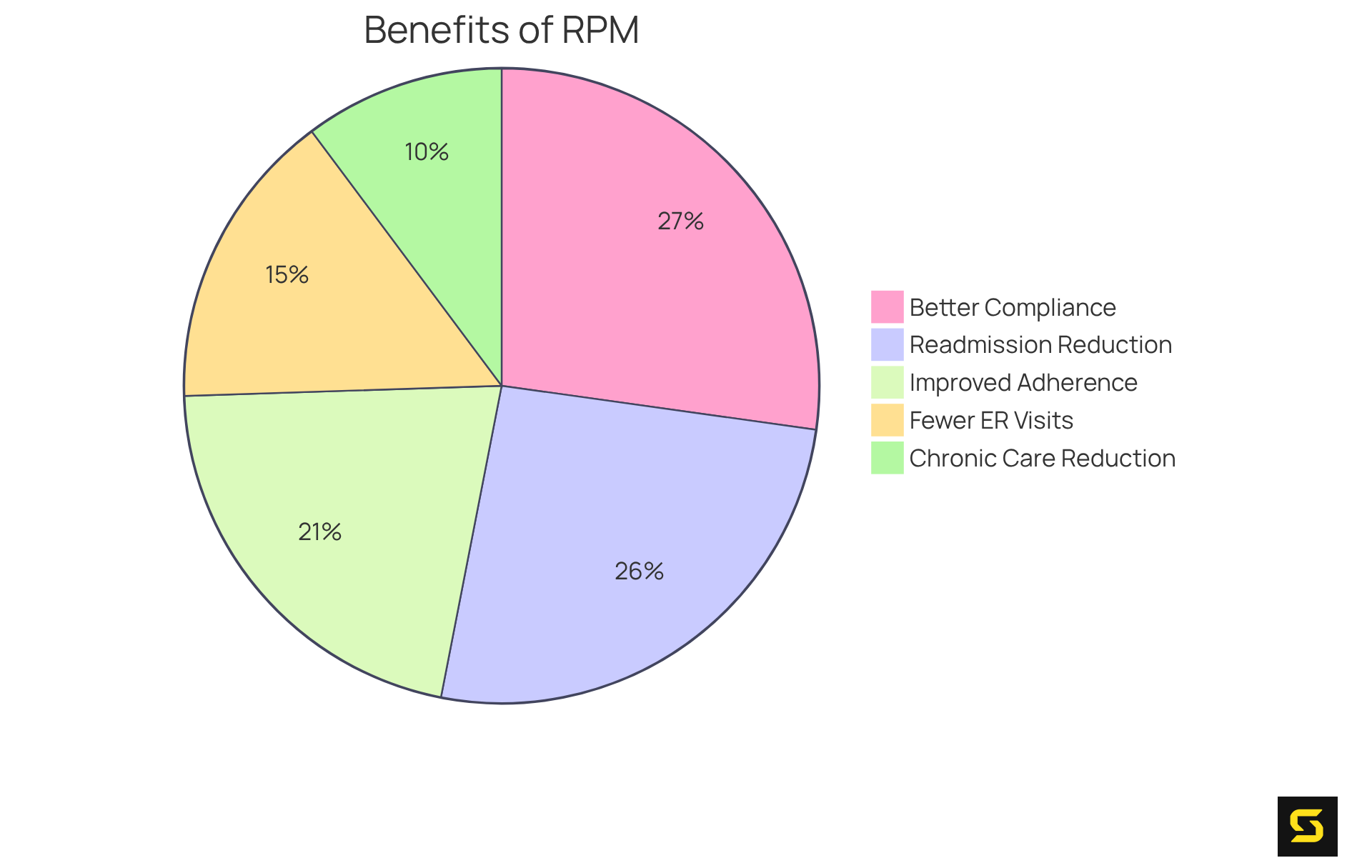
Secure Messaging: Enhancing Communication Between Patients and Providers
In telemedicine app development, secure messaging features are crucial for facilitating confidential communication between individuals and healthcare professionals. These systems must comply with HIPAA regulations, ensuring that all communications are encrypted and securely stored. This compliance not only protects confidential client information but also fosters trust between individuals and healthcare professionals. For instance, studies reveal that 93% of patients felt their needs were adequately addressed during video visits, underscoring the effectiveness of secure messaging in enhancing patient satisfaction.
Moreover, the reliance on secure messaging has surged, with a reported 200% increase in secure messages received by providers in recent years. This trend highlights the escalating significance of telemedicine app development in these systems. However, it is vital to recognize the negative correlation between secure message exchanges and client satisfaction, particularly among underrepresented minorities, indicating challenges that require attention.
By offering a reliable platform for discussing health issues, appointment notifications, and follow-up care, secure messaging significantly improves the overall experience for individuals seeking care. Telemedicine app development, such as that seen in applications like Updox, exemplifies the integration of HIPAA-compliant messaging solutions that enhance communication while safeguarding client information. Furthermore, 61% of doctors have noted a decline in no-show rates among clients since implementing remote health consultations, further emphasizing the effectiveness of secure messaging in boosting engagement and access to care.
As remote healthcare continues to expand, the telemedicine app development will be pivotal in ensuring effective and compliant interactions between providers and individuals through secure messaging systems, ultimately leading to improved health outcomes and increased engagement. To enhance your virtual healthcare application, consider incorporating robust secure messaging functionalities that prioritize HIPAA compliance and address the unique challenges faced by diverse user groups.
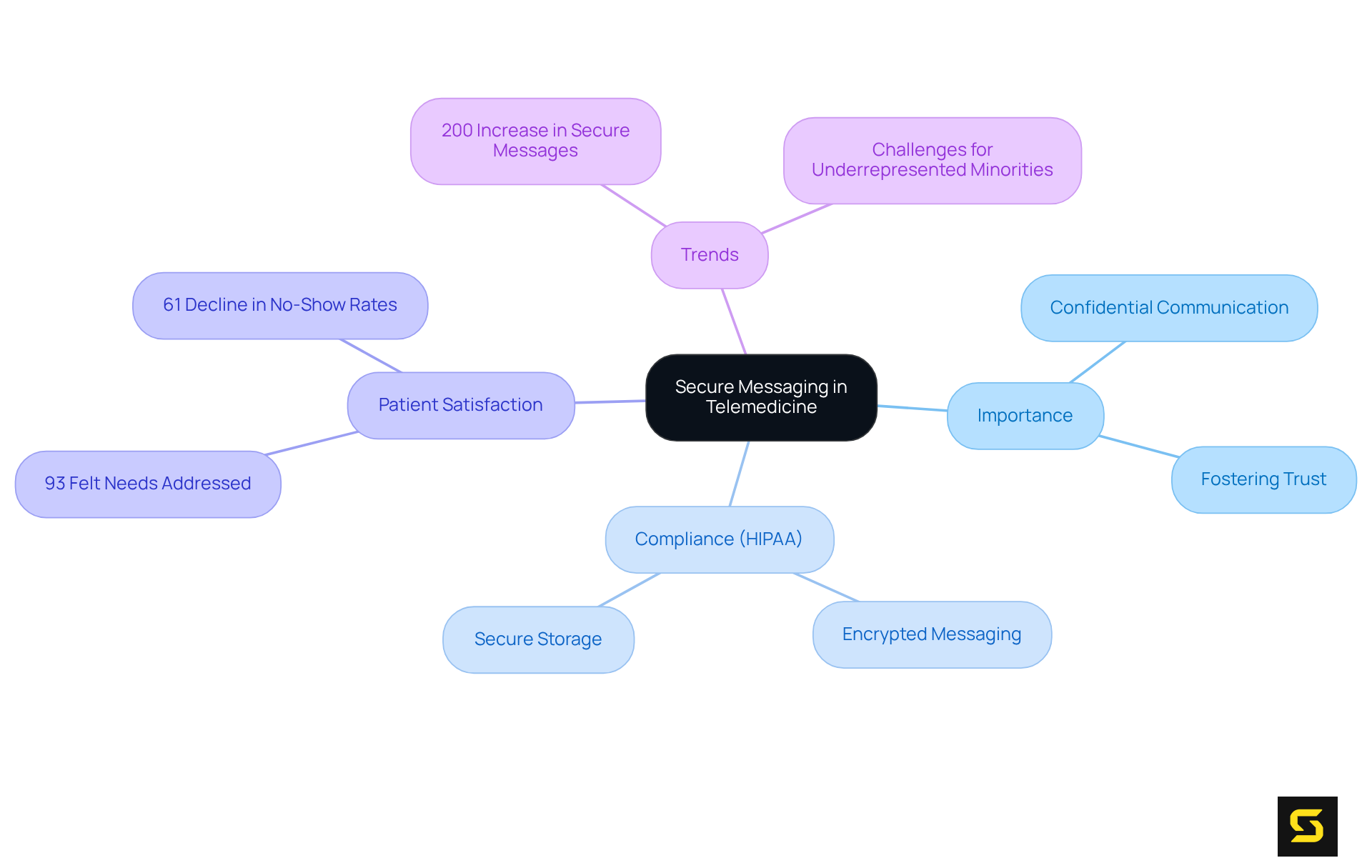
Appointment Scheduling: Streamlining Patient Management
An effective appointment scheduling system is essential for telemedicine applications, empowering individuals to book, reschedule, and cancel appointments with ease. Features such as calendar synchronization, automated reminders, and real-time availability significantly diminish no-show rates, which tend to be alarmingly high when convenient booking options are absent.
In fact, 67% of individuals favor online booking in medical services, highlighting the critical importance of offering accessible scheduling alternatives. By optimizing the scheduling process, healthcare providers can enhance operational efficiency and focus more on patient care, as freeing up staff resources allows for a greater emphasis on activities that directly improve care quality.
Self-scheduling tools provide individuals with 24/7 appointment management, fostering engagement and loyalty. As the remote healthcare market continues to surge, projected to reach $286.22 billion by 2030, the demand for efficient scheduling solutions is poised to escalate.
Companies that utilize online reservation systems can see an average revenue increase of 27%, making it imperative for suppliers to adopt these technologies to meet client expectations and enhance the overall delivery of medical services.
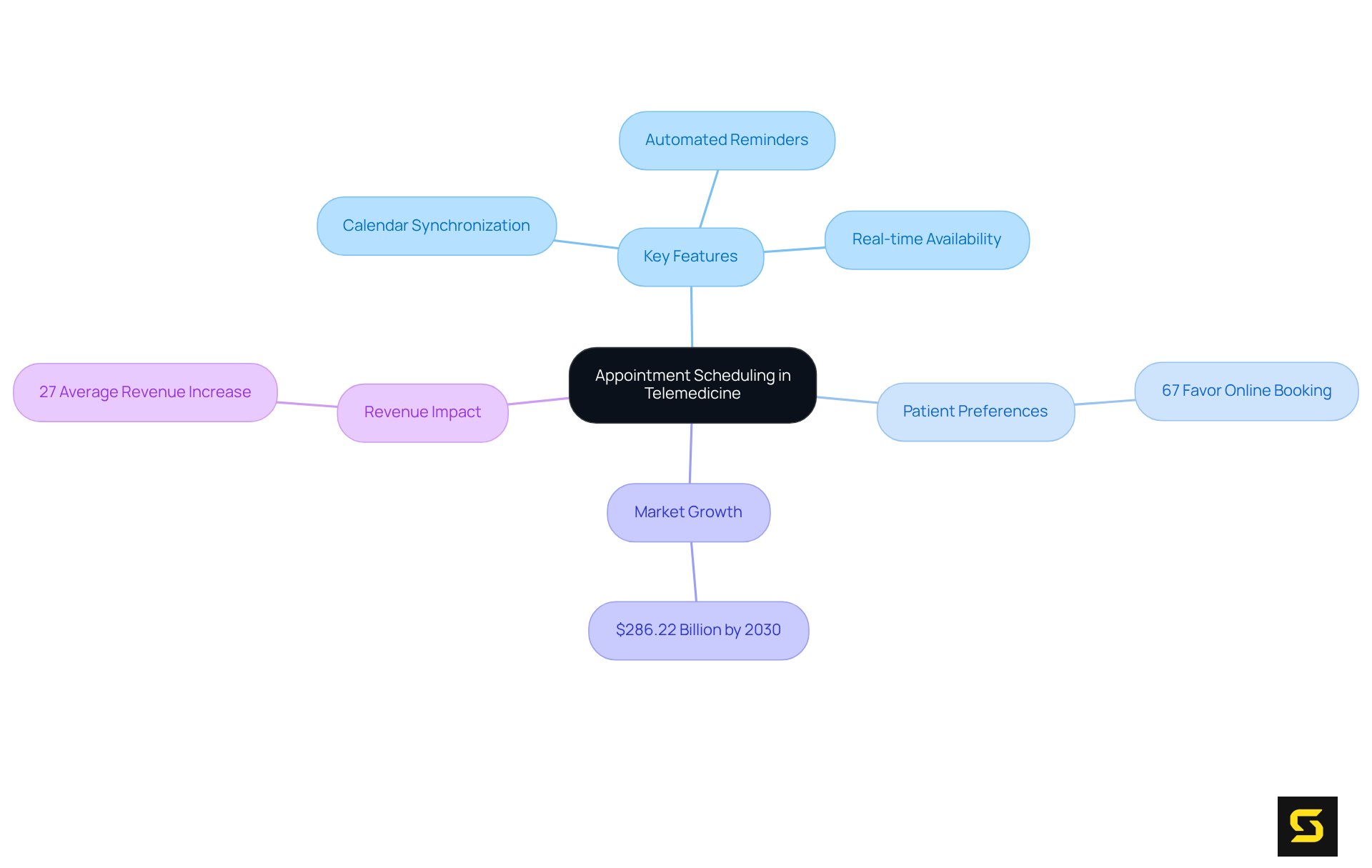
Analytics and Reporting: Gaining Insights for Continuous Improvement
Incorporating analytics and reporting capabilities into remote healthcare applications is essential for medical professionals aiming to monitor key performance indicators (KPIs) and evaluate the effectiveness of their services. By leveraging information on client engagement, appointment outcomes, and user satisfaction, providers can pinpoint areas needing improvement and make data-driven decisions to enhance their telemedicine app development. Notably, a 23% increase in client satisfaction was recorded following the implementation of improved virtual waiting room experiences, showcasing the tangible benefits derived from data insights.
Moreover, the telehealth market, valued at $45.5 billion in 2020, is projected to soar to $175.7 billion by 2026, emphasizing the critical role of data analytics in this evolving sector. Effective utilization of KPIs, including successful encounter rates and client satisfaction metrics, is vital for optimizing telemedicine app development services. By consistently monitoring these indicators, healthcare organizations can ensure their remote healthcare solutions adapt to the changing needs of individuals and enhance overall healthcare delivery.
As Riken Shah asserts, the integration of data analytics is crucial for improving the quality of care and reducing missed appointments, ultimately leading to superior patient outcomes.
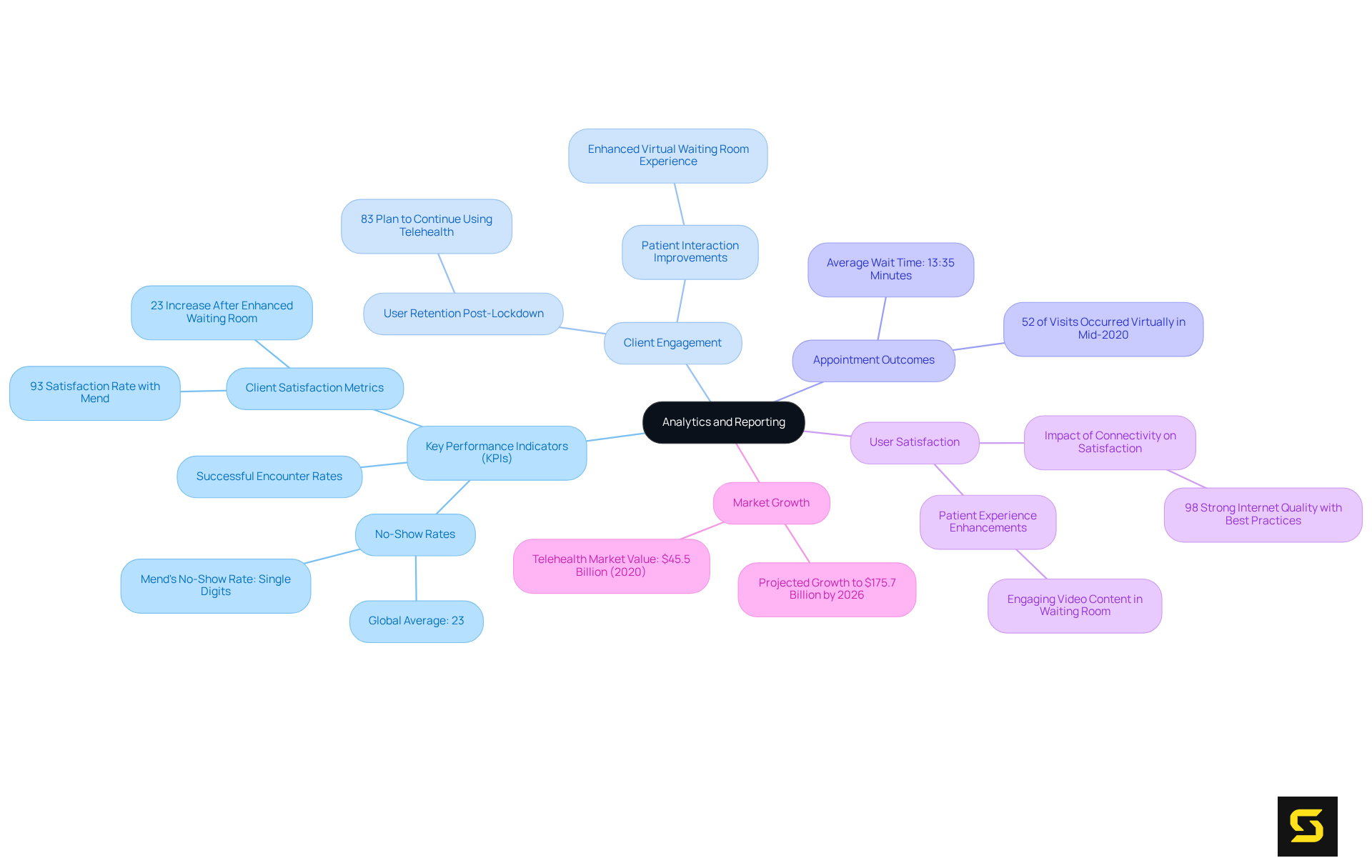
Ongoing Support and Maintenance: Ensuring Long-Term App Success
Continuous support and maintenance are paramount for the long-term success of telemedicine app development. Regular updates not only address security vulnerabilities but also enhance functionality by incorporating new features based on user feedback. This commitment to ongoing enhancement ensures that telemedicine solutions remain effective and relevant in an ever-evolving medical landscape.
Statistics indicate that applications with consistent maintenance experience a significant increase in user retention, with medical applications achieving up to a 30% higher retention rate when frequently updated. Furthermore, robust support systems empower users, fostering trust and satisfaction—both essential for sustained engagement.
As telemedicine app development continues to expand, the critical nature of maintaining these applications cannot be overstated, as it directly influences the quality of care delivered to patients and the operational efficiency of healthcare providers.
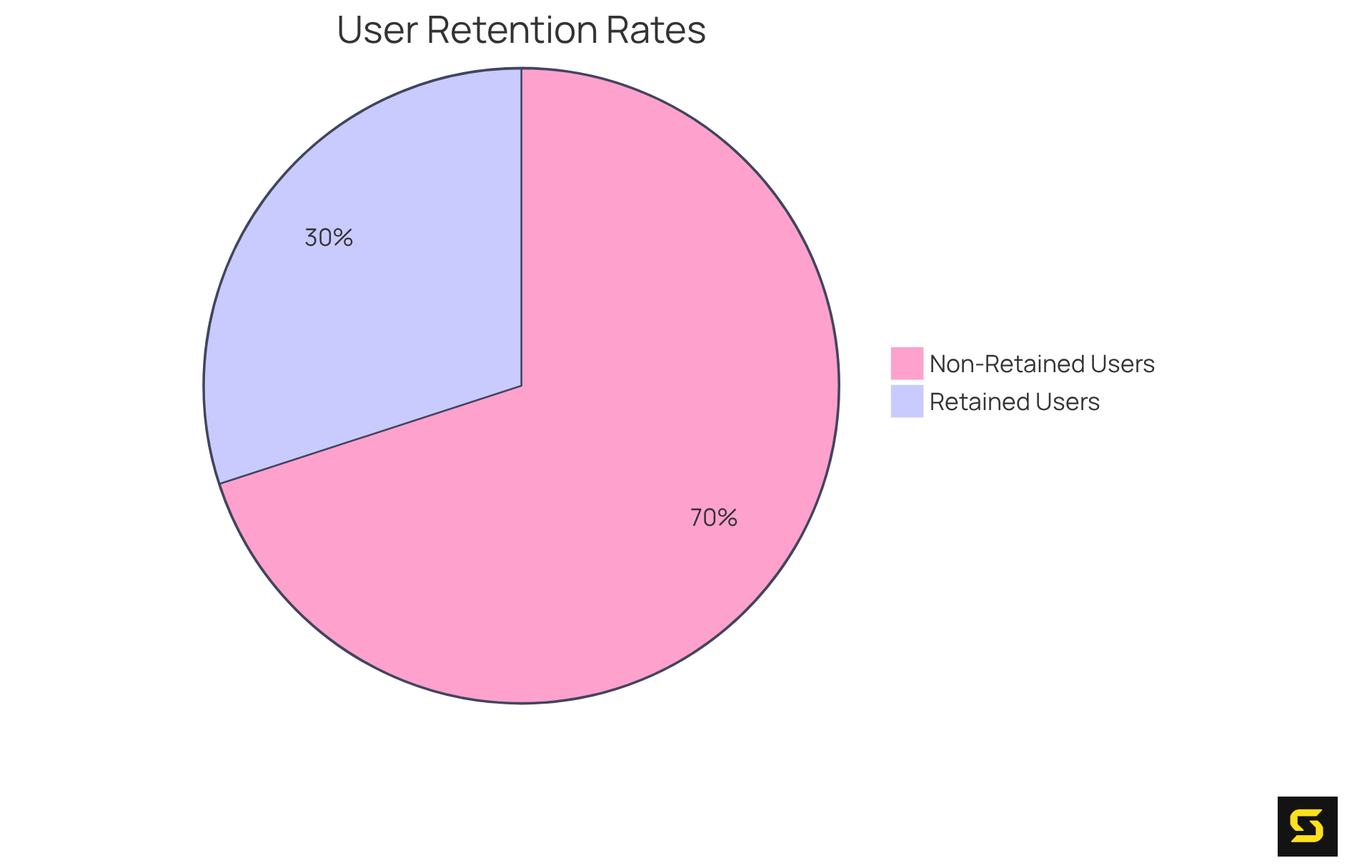
Conclusion
The advancement of telemedicine applications stands as a pivotal element in enhancing healthcare delivery within our increasingly digital environment. This article underscores the essential features that drive effective telemedicine app development, placing particular emphasis on:
- Customization
- User-friendly interfaces
- Robust security measures
By integrating cutting-edge technologies and prioritizing patient engagement, healthcare providers can develop applications that not only comply with regulatory standards but also significantly enhance the overall user experience.
Key arguments examined throughout the article highlight the critical nature of data security, especially in relation to HIPAA regulations, alongside the necessity for seamless EHR integration to enable real-time access to patient information. The significance of intuitive user interfaces and high-quality video conferencing capabilities is paramount, as these aspects directly influence user satisfaction and engagement. Moreover, features such as:
- Remote patient monitoring
- Secure messaging
- Efficient appointment scheduling
are indispensable for streamlining operations and improving communication between patients and providers.
As the telemedicine landscape continues to evolve, it is essential for healthcare organizations to stay ahead of emerging trends and embrace innovations that enhance service delivery. The incorporation of analytics and ongoing support for telemedicine applications will not only promote continuous improvement but also ensure that these solutions remain relevant and effective in addressing patient needs. By prioritizing these vital features, stakeholders within the healthcare sector can substantially elevate patient care, optimize workflows, and ultimately contribute to a more efficient healthcare system.
Frequently Asked Questions
What services does SDA provide in telemedicine app development?
SDA offers end-to-end app design, development, and seamless integration, delivering tailored solutions that meet the unique needs of healthcare providers.
What is the projected growth rate of the remote healthcare market?
The remote healthcare market is anticipated to grow at a compound annual growth rate (CAGR) of 17.32% during the forecast period.
What are the benefits of customized remote medical solutions?
Customized remote medical solutions improve access to services, reduce wait times, and enhance communication between individuals and providers.
What challenges do healthcare organizations face in adopting digital medical solutions?
Challenges include resistance to change and concerns regarding patient data security and privacy.
How important is data security in healthcare applications?
Data security is paramount, requiring strict adherence to HIPAA regulations and the implementation of advanced encryption protocols to safeguard individual privacy and maintain legal compliance.
What design principles are essential for creating user-friendly telemedicine apps?
Essential design principles include clear navigation, responsive layouts, and visually appealing elements that guide users through the app.
How does user interface design impact user engagement and satisfaction?
An intuitive user interface significantly influences user engagement and satisfaction, with research indicating that poor designs can lead to high visitor drop-off rates.
Why is user feedback important in the design process of telemedicine apps?
Incorporating user feedback helps developers create interfaces that accommodate a diverse range of users, enhancing accessibility and promoting active involvement in health journeys.
What role does a well-designed user interface play in the success of remote healthcare solutions?
A well-designed user interface can lead to increased engagement rates and fosters trust, making it a crucial element for the success of telemedicine app development.





